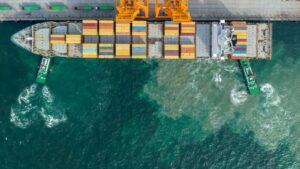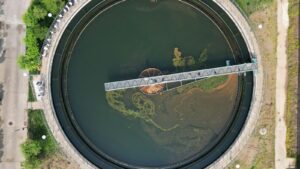Aquaculture Innovation and Trends: Part 2
Seaweed is quickly gaining a reputation as one of the most versatile and promising climate-friendly crop. Innovators are identifying sustainability applications for seaweed as a methane-reducing livestock feed additive, nutritious and low-carbon food ingredient, regenerative crop input, and a sustainable alternative to plastics and fossil fuels, among many others.
Seaweed collection for food and fuel has been undertaken by coastal populations for centuries while the first record of seaweed cultivation dates back to 1670 in Japan. Today, East Asia dominates global seaweed cultivation. The top three producers by a significant margin are China, Indonesia, and the Republic of Korea (FAO, 2021) where seaweed is harvested and processed to develop food and cosmetics ingredients such as sodium alginate and sorbitol (Innovation Norway, 2018). Additionally, seaweed farms provide food products to meet local demand and seaweed cultivation and harvesting support for the economic development of many rural, coastal communities.
Corporate interest is driven by a desire to meet sustainability and decarbonization goals by reducing the carbon footprint of their products by incorporating seaweed-based food ingredients and biomaterials. Seaweed is an abundant, low-impact, and extremely fast-growing source of biomass that does not require fertilizer or herbicides and can be cultivated and harvested with minimal technology. As a food source, it is rich in protein as well as a wide range of vitamins and minerals including iodine, iron, and calcium.
In recent years, corporate and national decarbonization goals have driven increasing investment and innovation in seaweed cultivation and the development of seaweed-based products. Confronted with low crop yields, limited agricultural resources, and growing populations, national governments and international bodies are turning to seaweed to ease food security challenges, boost coastal economies, and reduce agricultural emissions (Seaweed for Europe, 2022).
Innovation, End Markets, and Challenges
Innovators are developing seaweed-based products to address a wide range of climate challenges: from ecosystem degradation and food security to plastic waste, livestock methane emissions and reliance on fossil fuels.
While there are a wide range of products, drivers, and end-markets, the seaweed value chain is straightforward: seaweed farmers cultivate and harvest seaweed to be sold either directly as a food product or as biomass to be processed and converted into a variety of seaweed-based products. Some innovators are vertically integrated, undertaking cultivation, bioprocessing, and final product development (e.g., Biome Algae, UK), while others focus solely on cultivation (e.g., Arctic Seaweed, Norway), bioprocessing, or product development (e.g., Sway, USA).
End products and markets vary based on seaweed species, local market conditions, and biomass supply as well as the sustainability and climate goals of each innovator. Biomass supply is a particularly important factor: while the nascent industry continues to develop the capacity to produce seaweed biomass, innovators tend to focus on higher value products such as food and feed ingredients and bioplastics. Significant scaling of cultivation and bioprocessing capacity will support the development of lower-value products such as biofuels and fertilizers.
Currently, there are significant challenges to the scaling of global seaweed production and global seaweed supply. Regulatory and licensing inefficiencies pose the greatest barrier: while national conditions vary, in most countries licensing and approval processes are convoluted, prohibitively expensive, and time consuming. In some countries, such as the United States, local and federal processes and regulations lack coordination, posing additional bureaucratic and economic barriers to potential innovators and the growth of existing farms.
Additionally, scaling of seaweed production requires high-capacity bioprocessing, and vice versa. Large scale seaweed bioprocessing facilities are viable only if there is a constant input of seaweed biomass. In turn, demand from bioprocessing facilities is essential to drive the scaling of seaweed production. Effective infrastructure is required to connect seaweed farmers with industrial scale bioprocessing facilities. This might take the form of a spoke and hub model, with one bioprocessing facility taking biomass input from a number of seaweed farms in the same region, providing bio-processors with sufficient biomass while supporting farmers in the scale-up of production.
Several notable seaweed end markets are:
Seaweed-based feed additives to reduce livestock methane emissions are currently one of the hottest topics in seaweed-based products. Globally, livestock account for about 40% of agriculture-related methane emissions. This month saw the first commercial sale of CH4 Global´s proprietary feed supplement that reduces the methane emission of cattle by up to 90% as well as increasing investment (Symbrosia, Hawaii) and corporate partnerships (Blue Ocean Barns, Hawaii). Demand for methane-reducing feed additives is driven by national governments with significant agricultural emissions, such as New Zealand, as well as large dairy and beef corporates looking to reduce emission to align with corporate strategies or emission-reduction regulations.
Bioplastics innovators (e.g., NotPla, UK) are tackling plastic waste and emissions from plastic production by developing seaweed-based biodegradable alternatives to single-use plastics and packaging. A strong pull from climate-conscious consumers that are willing to pay for locally sourced and sustainable plastic alternatives drive the market for seaweed-based bioplastics.
Agricultural additives such as bio-stimulants have been shown to improve crop yield, overall crop health, and reduce dependence on synthetic fertilizers. The market for bio-stimulants is relatively unsaturated, with innovators typically providing a range of seaweed-based products alongside bio-stimulants (e.g., Primary Ocean, USA). The increasing cost of fertilizers, low crop yields and climate-stress on crops due to drought and extreme temperatures, as well as the implementation of incentives for regenerative agriculture practices drive a growing demand for these products.
On the Horizon
Integration of seaweed farms with existing fishing and offshore wind infrastructure is a potential path towards scaling global seaweed production. Innovators such as UK-based Cultivocean plan to co-locate seaweed farms and offshore windfarms in order to simplify and facilitate licensing and permitting processes. Canadian seaweed cultivators (e.g., Cascadia Seaweed) have partnered with local First Nations to obtain licenses and collaborate on seeding and harvesting, modelling employment benefits and the successful integration of seaweed cultivation into to coastal fishing economies.
Corporate partnerships will be key to the demand for seaweed-based food ingredients, spurring investment that will allow for scaling and commercialization, as well as driving widespread consumer acceptance of seaweed as a food ingredient in Europe and the Americas.
Alternative proteins pose an additional opportunity for the commercialization of seaweed-based food ingredients. An increasing variety of plant-based protein alternatives are hitting the shelves as climate-conscious consumers demand sustainable alternatives to meat, seafood, and dairy. The high quality of seaweed-based protein and its low carbon footprint make seaweed-based products attractive in the plant-based foods sector (e.g., Umaro Foods, USA).
The next few years will be critical for the seaweed industry. As 2030 looms, a key year to measure global progress towards 2050 decarbonization goals, the sustainable qualities of seaweed are attracting growing investment and innovation. However, players in the seaweed sector and governing bodies must collaborate to quickly overcome scaling challenges in order to justify continued investment and demonstrate the global impact of large-scale seaweed cultivation and processing.



